Chapter 6: Serial Communication Modules
EUSART
The Enhanced Universal Synchronous Asynchronous Receiver Transmitter (EUSART) module is a serial I/O communication peripheral. It is also known as Serial Communications Interface (SCI). It contains all clock generators, shift registers and data buffers necessary to perform an input or output serial data transfer independently of the device program execution. As its name states, apart from the usage of clock for synchronization, this module can also establish asynchronous connection, which makes it irreplaceable in some applications.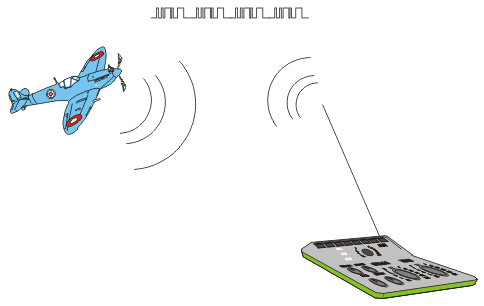
For example, in the event that it is difficult or impossible to provide special channels for clock and data transfer (for example, radio remote control or infrared), the EUSART module presents itself as a convenient solution.
The EUSART system integrated into the PIC16F887 microcontroller has the following features:
- Full-duplex asynchronous transmit and receive;
- Programmable 8- or 9-bit character length;
- Address detection in 9-bit mode;
- Input buffer overrun error detection; and
- Half-duplex communication in synchronous mode (master or slave).
EUSART Asynchronous Mode
The EUSART transmits and receives data using standard non-return-to-zero (NRZ) format. As seen in figure 6-2 below, this mode does not use clock signal, while the data format being transferred is very simple:
Fig. 6-2 EUSART Asynchronous Mode
- In idle state, data line has high logic level (1);
- Each data transmission starts with START bit which is always a zero (0);
- Each data is 8- or 9-bit wide (LSB bit is first transferred); and
- Each data transmission ends with STOP bit which always has logic level which is always a one (1).
EUSART Asynchronous Transmitter
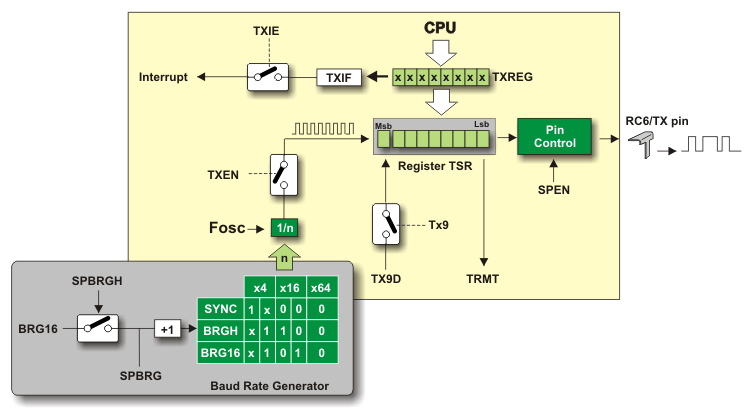
Fig. 6-3 EUSART Asynchronous Transmitter
TXEN = 1 - EUSART transmitter is enabled by setting this bit of the TXSTA register;
SYNC = 0 - EUSART is configured to operate in asynchronous mode by clearing this bit of the TXSTA register; and
SPEN = 1 - By setting this bit of the RCSTA register, EUSART is enabled and the TX/CK pin is automatically configured as output. If this bit is simultaneously used for some analog function, it must be disabled by clearing the corresponding bit of the ANSEL register.
The central part of the EUSART transmitter is the shift register TSR which is not directly accessible by the user. In order to start transmission, the module must be enabled by setting the TXEN bit of the TXSTA register. Data to be sent should be written to the TXREG register, which will cause the following sequence of events:
- Byte will be immediately transferred to the shift register TSR;
- TXREG register remains empty, which is indicated by setting flag bit TXIF of the PIR1 register. If the TXIE bit of the PIE1 register is set, an interrupt will be generated. Besides, the flag is set regardless of whether an interrupt is enabled or not. Also, it cannot be cleared by software, but by writing new data to the TXREG register;
- Control electronics "pushes" data toward the TX pin in rhythm with internal clock: START bit (0) ... data ... STOP bit (1);
- When the last bit leaves the TSR register, the TRMT bit of the TXSTA regis ter is automatically set; and
- If the TXREG register has received a new character data in the meantime, the whole procedure is repeated immediately after the STOP bit of the previous character has been transmitted.
EUSART Asynchronous Receiver
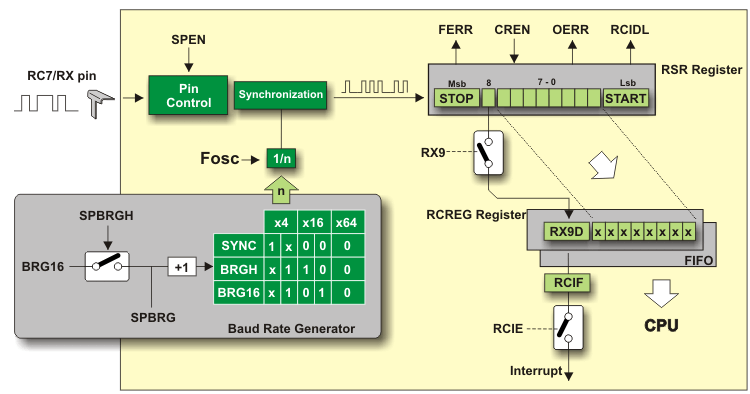
Fig. 6-4 EUSART Asynchronous Receiver
CREN = 1 - EUSART receiver is enabled by setting this bit of the RCSTA register;
SYNC = 0 - EUSART is configured to operate in asynchronous mode by clearing this bit stored in the TXSTA register; and
SPEN = 1 - By setting this bit of the RCSTA register, EUSART is enabled and the RX/DT pin is automatically configured as input. If this bit is simultaneously used for some analog function, it must be disabled by clearing the corresponding bit of the ANSEL register.
When this first and necessary step is accomplished and START bit is detected, data is transferred to the shift register RSR through the RX pin. When the STOP bit has been received, the following occurs:
- Data is automatically transferred to the RCREG register (if empty);
- The flag bit RCIF is set and an interrupt, if enabled by the RCIE bit of the PIE1 register, occurs. Similar to transmitter, the flag bit is cleared by software only, i.e. by reading the RCREG register. Bear in mind that this is a two character FIFO memory (first-in, first-out) which allows reception of two characters simultaneously;
- If the RCREG register is occupied (contains two bytes) and the shift register detects new STOP bit, the overflow bit OERR will be set. In this case, a new coming data is lost, and the OEER bit must be cleared by software. It is done by clearing and resetting the CREN bit.
Note: it is not possible to receive new data as far as the OERR bit is set; - If the STOP bit is zero (0), the FERR bit of the RCSTAregister detecting receive error will be set; and
- To receive 9-bit data it is necessary to set the RX9 bit of the RCSTA register.
Receive Error Detection
There are two types of errors which the microcontroller can automatically detect. The first one is called Framing error and occurs when the receiver does not detect the STOP bit at the expected time. Such error is indicated via the FERR bit of the RCSTA register. If this bit is set, it means that the last received data may be incorrect. It is important to know several things:- A Framing error does not generate an interrupt by itself;
- If this bit is set, the last received data has an error;
- A framing error (bit set) does not prevent reception of new data;
- The FERR bit is cleared by reading received data, which means that check must be done before data reading; and
- The FERR bit cannot be cleared by software. If needed, it can be cleared by clearing the SPEN bit of the RCSTA register. It will simultaneously cause reset of the whole EUSART system.
- Data already stored in the FIFO registers (two bytes) can be normally read;
- No additional data will be received until the OERR bit is cleared; and
- This bit is not directly accessed. To clear it, it is necessary to clear the CREN bit of the RCSTA register or to reset the whole EUSART system by clearing the SPEN bit of the RCSTA register.
Receiving 9-bit Data
In addition to receiving standard 8-bit data, the EUSART system supports 9-bit data reception. On the transmit side, the ninth bit is "attached" to the original byte just before the STOP bit. On the receive side, when the RX9 bit of the RCSTA register is set, the ninth data bit will be automatically written to the RX9D bit of the same register. When this byte is received, one should take care of how to read its bits- the RX9D data bit must be read before reading the 8 least significant bits of the RCREG register. Otherwise, the ninth data bit will be automatically cleared.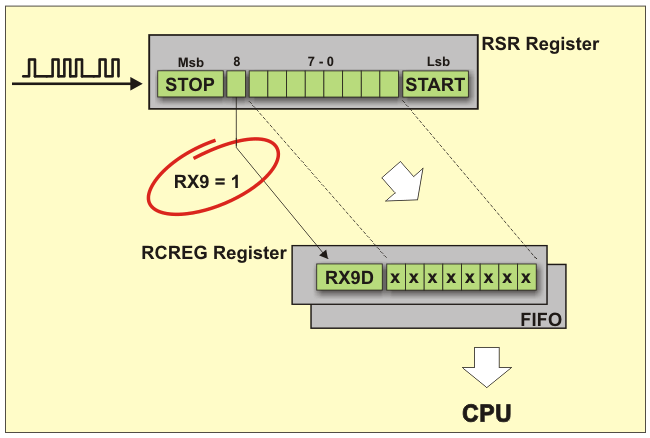
Fig. 6-5 Receiving 9-bit Data
Address Detection
When the ADDEN bit of the RCSTAregister is set, the EUSART module is able to receive only 9-bit data, whereas all 8-bit data will be ignored. Although it seems like a restriction, such modes enable serial communication between several microcontrollers. The principle of operation is simple. The master device sends 9-bit data which represents the address of one microcontroller. All slave microcontrollers sharing the same transmission line, receive this data. Of course, each of them must have the ADDEN bit set because it enables address detection.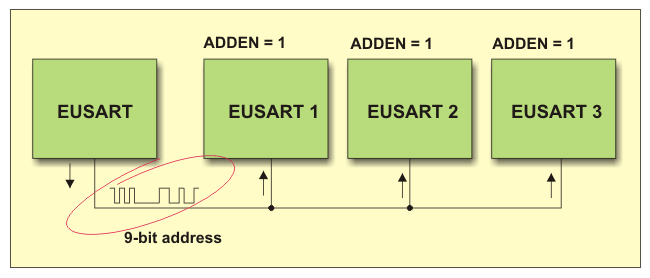
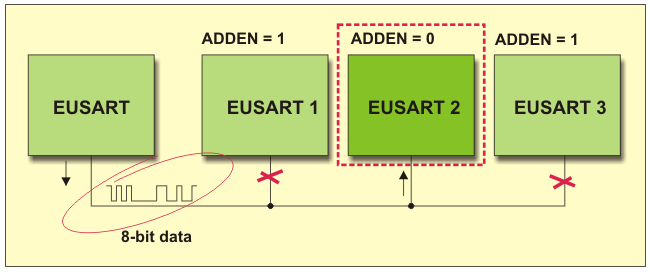
Fig. 6-7 Sending Data
TXSTA Register

Fig.6-8 TXSTA Register
- 1 - Master mode. Clock is generated internally from Baud Rate Generator; and
- 0 - Slave mode. Clock is generated from external source.
- 1 - 9-bit data transmission via EUSART system; and
- 0 - 8-bit data transmission via EUSART system.
- 1 - Transmission enabled; and
- 0 - Transmission disabled.
- 1 - EUSART operates in synchronous mode; and
- 0 - EUSART operates in asynchronous mode.
- 1 - Sending Break character is enabled; and
- 0 - Break character transmission is completed.
- 1 - EUSART operates at high speed; and
- 0 - EUSART operates at low speed.
- 1 - TSR register is empty; and
- 0 - TSR register is full.
RCSTA Register

Fig.6-9 RCSTA Register
- 1 - Serial port enabled. RX/DT and TX/CK pins are automatically configured as input and output respectively; and
- 0 - Serial port disabled.
- 1 - Receiving 9-bit data via EUSART system; and
- 0 - Receiving 8-bit data via EUSART system.
- 1 - Single receive enabled; and
- 0 - Single receive disable.
Asynchronous mode:
- 1 - Receiver enabled; and
- 0 - Receiver disabled.
- 1 - Enables continuous receive until the CREN bit is cleared; and
- 0 - Disables continuous receive.
- 1 - Enables address detection on 9-bit data receive; and
- 0 - Disables address detection. The ninth bit can be used as parity bit.
- 1 - On receive, Framing Error is detected; and
- 0 - No framing error.
- 1 - On receive, Overrun Error is detected; and
- 0 - No overrun error.
EUSART Baud Rate Generator (BRG)
If you carefully look at the asynchronous EUSART receiver or transmitter diagram, you will see, in both cases, that clock signal from the local timer BRG is used for synchronization. The same clock source is also used in synchronous mode.This timer consists of two 8-bit registers comprising one 16-bit register.

Fig. 6-10 EUSART Baud Rate Generator (BRG)
The formula used to determine Baud Rate is given in the table below.
| Bits | BRG / EUSART Mode | Baud Rate Formula | ||
|---|---|---|---|---|
| SYNC | BRG1G | BRGH | ||
| 0 | 0 | 0 | 8-bit / asynchronous | Fosc / [64 (n + 1)] |
| 0 | 0 | 1 | 8-bit / asynchronous | Fosc / [16 (n + 1)] |
| 0 | 1 | 0 | 16-bit / asynchronous | Fosc / [16 (n + 1)] |
| 0 | 1 | 1 | 16-bit / asynchronous | Fosc / [4 (n + 1)] |
| 1 | 0 | X | 8-bit / asynchronous | Fosc / [4 (n + 1)] |
| 1 | 1 | X | 16-bit / asynchronous | Fosc / [4 (n + 1)] |
Table 6-1 Baud Rate
The following tables contain values that should be written to the 16-bit register SPBRG and assigned to the SYNC, BRGH and BRGH16 bits in order to obtain some of the standard baud rates.The formulas used to determine the Baud Rate are:

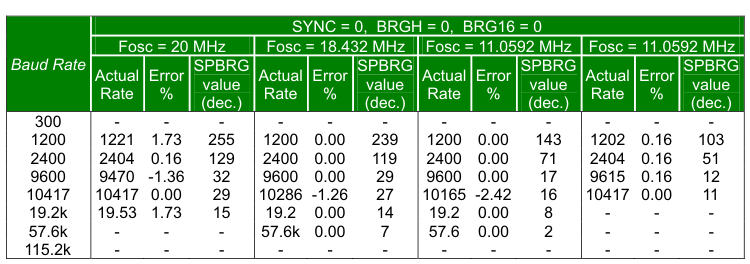
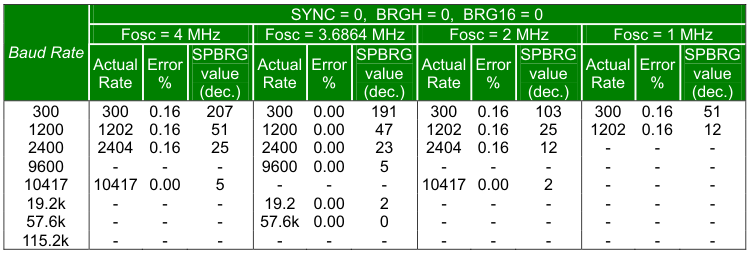

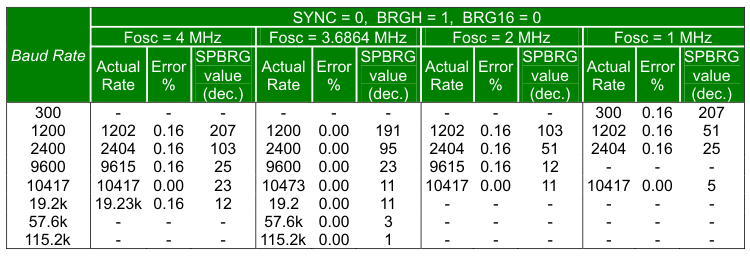

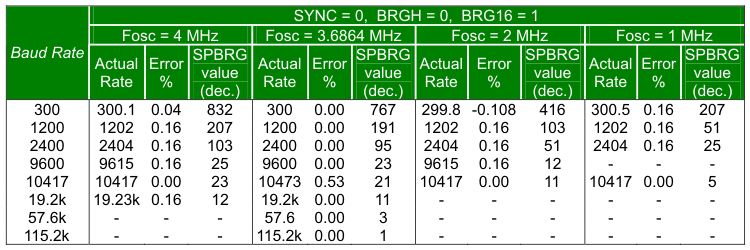
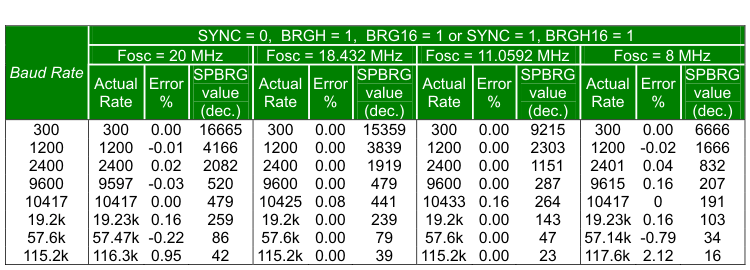

Table 6-2 Determining Baud Rate
BAUDCTL Register

Fig. 6-11 BAUDCTL Register
- 1 - Auto-baud timer overflowed; and
- 0 - Auto-baud timer did not overflow.
- 1 - Receiver is idle; and
- 0 - START bit has been received and receiving is in progress.
Asynchronous mode:
- 1 - Transmit inverted data to the RC6/TX/CK pin; and
- 0 - Transmit non-inverted data to the same pin.
- 1 - Synchronization on rising edge of the clock; and
- 0 - Synchronization on falling edge of the clock.
- 1 - Receiver waits for a falling edge on the RC7/RX/DT pin to start waking up the microcontroller from sleep mode; and
- 0 - Receiver operates normally.
- 1 - Auto-baud detect mode is enabled. Bit is automatically cleared on baud rate detect; and
- 0 - Auto-baud detect mode is disabled.
In Short:
Sending data via asynchronous EUSART communication:- The desired baud rate should be set by using bits BRGH (TXSTA register) and BRG16 (BAUDCTL register) and registers SPBRGH and SPBRG;
- The SYNC bit (TXSTA register) should be cleared and the SPEN bit should be set (RCSTA register) in order to enable serial port;
- On 9-bit data transmission, the TX9 bit of the TXSTA register should be set;
- Data transmission is enabled by setting bit TXEN of the TXSTA register. Bit TXIF of the PIR1 register is automatically set;
- If needed the bit TXEN causes an interrupt, the GIE and PEIE bits of the INTCON register should be set;
- On 9-bit data transmission, value of the ninth bit should be written to the TX9D bit of the TXSTA register; and
- Transmission starts by writing 8-bit data to the TXREG register.
- Baud Rate should be set by using bits BRGH (TXSTA register) and BRG16 (BAUDCTL register) and registers SPBRGH and SPBRG;
- The SYNC bit (TXSTA register) should be cleared and the SPEN bit should be set (RCSTA register) in order to enable serial port;
- If it is necessary the data receive causes an interrupt, both the RCIE bit of the PIE1 register and bits GIE and PEIE of the INTCON register should be set;
- On 9-bit data receive, the RX9 bit of the RCSTA register should be set;
- Data receive should be enabled by setting the CREN bit of the RCSTA register;
- The RCSTA register should be read to get information on possible errors which have occurred during transmission. On 9-bit data receive, the ninth bit will be stored in this register; and
- Received 8-bit data stored in the RCREG register should be read.
- Baud Rate should be set by using bits BRGH (TXSTA register) and BRG16 (BAUDCTL register) and registers SPBRGH and SPBRG;
- The SYNC bit (TXSTA register) should be cleared and the SPEN bit should be set (RCSTA register) in order to enable serial port;
- If it is necessary the data receive causes an interrupt, the RCIE bit of the PIE1 bit as well as bits GIE and PEIE of the INTCON register should be set;
- The RX9 bit of the RCSTA register should be set;
- The ADDEN of the RCSTA register should be set, which enables a data to be interpreted as address;
- Data receive is enabled by setting the CREN bit of the RCSTA register;
- Immediately upon 9-bit data is received, the RCIF bit of the PIR1 register will be automatically set. If enabled, an interrupt occurs;
- The RCSTA register should be read in order to get information on possible errors which have occurred during transmission. The ninth bit RX9D is always set; and
- Received 8-bits stored in the RCREG register should be read. It should be checked whether the combination of these bits matches the predefined address. If the match occurs, it is necessary to clear the ADDEN bit of the RCSTA register, which enables further 8-bit data receive.
Master Synchronous Serial Port Module
MSSP module (Master Synchronous Serial Port) is a very useful, but at the same time one of the most complex circuit within the microcontroller. It enables high speed communication between a microcontroller and other peripherals or microcontroller devices by using few input/output lines (maximum two or three). Therefore, it is commonly used to connect the microcontroller to LCD displays, A/D converters, serial EEPROMs, shift registers etc. The main feature of this type of communication is that it is synchronous and suitable for use in systems with a single master and one or more slaves. A master device contains the necessary circuitry for baud rate generation and supplies the clock for all devices in the system. Slave devices may in that way eliminate the internal clock generation circuitry. The MSSP module can operate in one of two modes:- SPI mode (Serial Peripheral Interface)
- I²C mode (Inter-Integrated Circuit)
If the microcontroller to be programmed controls another device or circuit (peripherals), it should operate as a master device. A module defined as such will generate clock when needed, i.e. only when data receive and transmit is required by the software. It depends on the master whether the connection will be established or not. Otherwise, if the microcontroller to be programmed is a part of some peripheral which belongs to some more complex device (for example PC), then it should operate as a slave device. As such, it always has to wait for request for data transfer from master device.
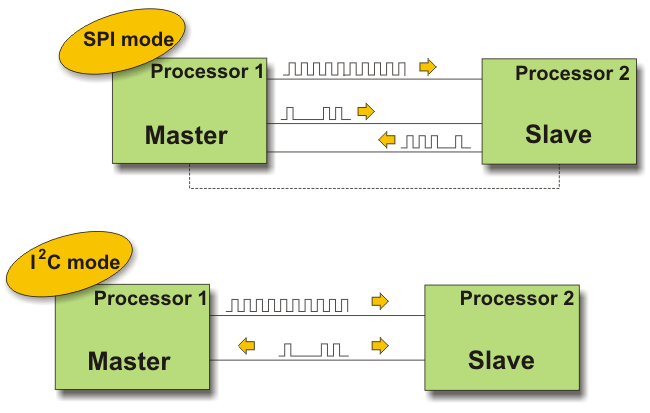
Fig.6-12 MSSP Module
SPI Mode
The SPI mode allows 8 bits of data to be transmitted and received simultaneously using 3 input/output lines:- SDO - Serial Data Out - transmit line;
- SDI - Serial Data In - receive line; and
- SCK - Serial Clock - synchronization line.
SS - Slave Select - is additional pin used for specific device selection. It is active only in case the microcontroller is in slave mode, i.e. when the external - master device requires data exchange.
When operating in SPI mode, MSSP module uses in total of 4 registers:
- SSPSTAT status register;
- SSPCON control register;
- SSPBUF buffer register; and
- SSPSR shift register (not directly available)
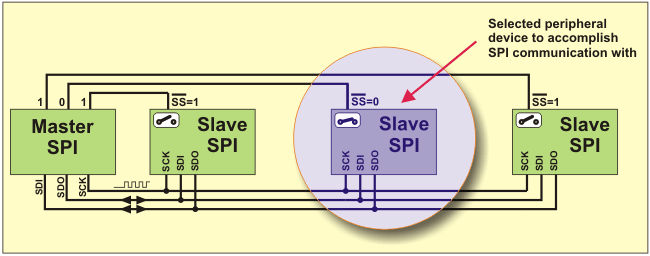
Fig. 6-13 SPI Mode
Shift register (SSPRS) is directly connected to the microcontroller pins and used for data transmission in serial format. The SSPRS register has its input and output and shifts the data in and out of device. In other words, each bit appearing on input (receive line) simultaneously shifts another bit toward output (transmit line).
The SSPBUF register (Buffer) is a part of memory used to temporarily hold the data written to the SSPRS until the received data is ready. Upon receiving all 8 bits of data, that byte is moved to the SSPBUF register. This double buffering of the received data (SSPBUF) allows the next byte to start reception before reading the data that was just received. Any write to the SSPBUF register during transmission/reception of data will be ignored. Since having been the most accessed, this register is considered the most important from the programmers’ point of view.
Namely, if mode settings are neglected, data transfer via SPI actually means to write and read data from this register, while another "acrobatics" such as moving registers are automatically performed by hardware.

Fig. 6-14 SPI Mode
In short:
Prior to initializing the SPI, it is necessary to specify several options:- Master mode (SCK pin is the clock output);
- Slave mode (SCK pin is the clock input);
- Data input phase- middle or end of data output time (SMP bit);
- Clock edge (CKE bit);
- Baud Rate (only in Master mode); and
- Slave select mode (Slave mode only).
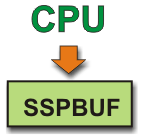
Step 1.
Data to transmit should be written to the buffer register SSPBUF. Immediately after that, if the SPI module operates in master mode, the microcontroller will automatically perform the following steps 2, 3 and 4. If the SPI module operates as Slave, the microcontroller will not perform these steps until the SCK pin detects clock signal.
Fig. 6-15 Step 1
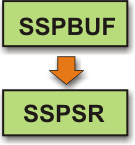
Step 2.
This data is now moved to the SSPSR register and the SSPBUF register is not cleared.
Fig. 6-16 Step 2
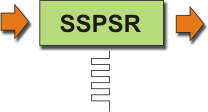
Step 3.
Synchronized with clock signal, this data is shifted to the output pin (MSB bit first) while the register is simultaneously being filled with bits through input pin. In Master mode, the microcontroller itself generates clock, while the Slave mode uses external clock (pin SCK).
Fig. 6-17 Step 3
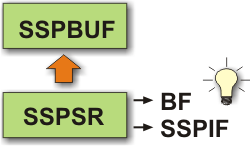
Step 4.
The SSPSR register is full once the 8 bits of data have been received. It is indicated by setting the BF and SSPIF bits. The received data (that byte) is automatically moved from the SSPSR register to the SSPBUF register. Since data transfer via serial communication is performed automatically, the rest of the program is normally executed while data transfer is in progress. In that case, the function of the SSPIF bit is to generate interrupt when one byte transmission is completed.
Fig. 6-18 Step 4
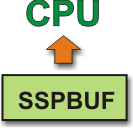
Step 5.
At last, the data stored in the SSPBUF register is ready for use and moved to any register available.
Fig. 6-19 Step 5
I²C mode
I²C mode (Inter IC Bus) is especially suitable when the microcontroller and integrated circuit, which the microcontroller should exchange data with, are within the same device. It is commonly about another microcontrollers or specialized, cheap integrated circuits belonging to the new generation of so called "smart peripheral components" (memories, temperature sensors, real-time clocks etc.)Similar to serial communication in SPI mode, data transfer in I²C mode is synchronous and bidirectional. This time only two pins are used for data transfer. These are the SDA (Serial Data) and SCL (Serial Clock) pins. The user must configure these pins as inputs or outputs through the TRISC bits.
Perhaps it is not directly visible. By observing particular rules (protocols), this mode enables up to 122 different components to be simultaneously connected in a simple way by using only two valuable I/O pins. Briefly, everything works as follows: Clock necessary to synchronize the operation of both devices is always generated by the master device (microcontroller) and its frequency directly affects baud rate. There are protocols allowing maximum 3,4 MHz clock frequency (so called high-speed I²C bus), but the clock frequency of the most frequently used protocol is limited to 100 KHz. There is no limit in case of minimal frequency.
When master and slave components are synchronized by the clock, every data exchange is always initialized by master. Once the MSSP module has been enabled, it waits for a Start condition to occur. First the master device sends the START bit (logic zero) through the SDA pin, then the 7-bit address of the selected slave device, and finally, the bit which requires data write (0) or read (1) to that device. Accordingly, following the start condition, the eight bits are shifted into the SSPSR register. All slave devices share the same transmission line and all will simultaneously receive the first byte, but only one of them has the address to match.
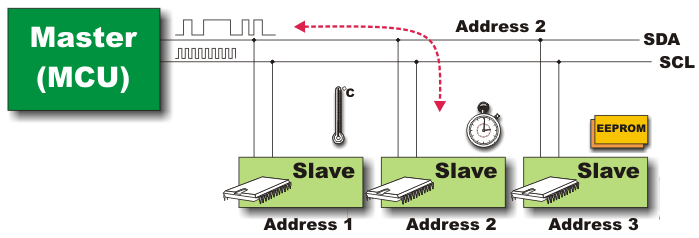
Fig. 6-20 Master and Slave Configuration
This is the simplest explanation of how two components communicate. If needed, this microcontroller is able to control more complicated situations when 1024 different components, shared by several different master devices, are connected. Such devices are rarely used in practice and there is no need to discuss them at greater length.
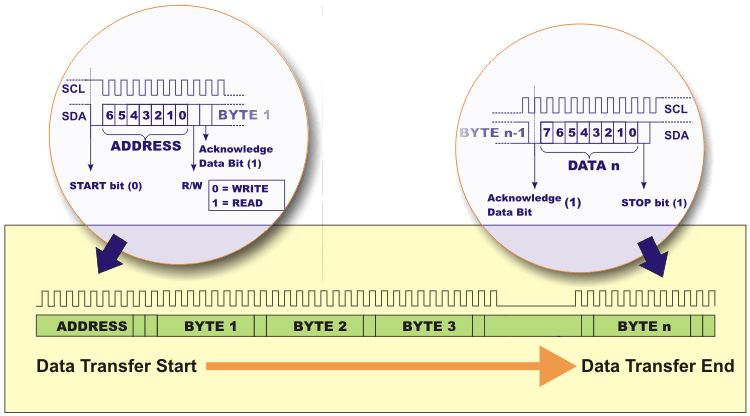
Fig. 6-21 Data Transfer
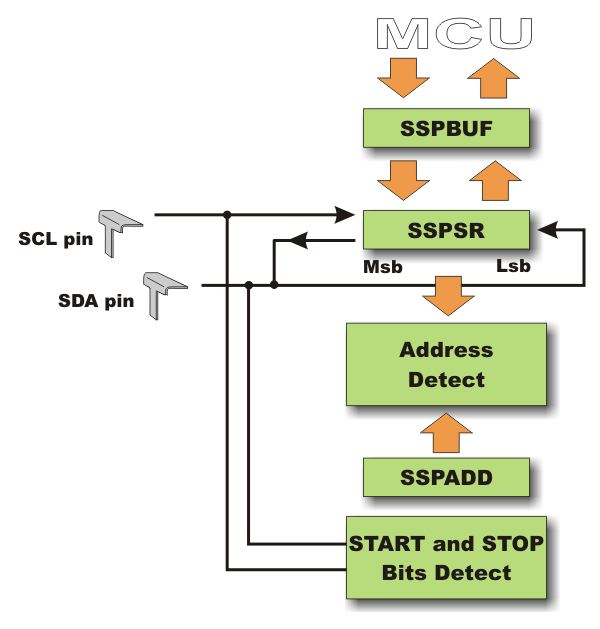
Fig. 6-22 MSSP Block Diagram in I²C Mode
- SSPCON;
- SSPCON2;
- SSPSTAT;
- SSPBUF;
- SSPSR; and
- SSPADD.
SSPSTAT Register

Fig. 6-23 SSPSTAT Register
SPI master mode - This bit determines input data phase.
- 1 - Logic state is read at end of data output time; and
- 0 - Logic state is read in the middle of data output time.
I²C mode (master or slave)
- 1 - Slew rate control disabled for standard speed mode (100kHz); and
- 0 - Slew rate control enabled for high speed mode (400kHz).
CKP = 0:
- 1 - Data is transmitted on rising edge of clock pulse (0 - 1); and
- 0 - Data is transmitted on falling edge of clock pulse (1 - 0).
- 1 - Data is transmitted on falling edge of clock pulse (1 - 0); and
- 0 - Data is transmitted on rising edge of clock pulse (0 - 1).
- 1 - Indicates that the last byte received or transmitted was data; and
- 0 - Indicates that the last byte received or transmitted was address.
- 1 - STOP bit was detected last; and
- 0 - STOP bit was not detected last.
- 1 - START bit was detected last; and
- 0 - START bit was not detected last.
In I²C slave mode
- 1 - Data read; and
- 0 - Data write.
- 1 - Transmit is in progress; and
- 0 - Transmit is not in progress.
- 1 - Indicates that it is necessary to update the address in the SSPADD register; and
- 0 - Address in the SSPADD register is correct and does not need to be updated.
During data receive (in SPI and I²C modes)
- 1 - Receive complete. The SSPBUF register is full; and
- 0 - Receive not complete. The SSPBUF register is empty.
- 1 - Data transmit in progress (does not include the bits ACK and STOP); and
- 0 - Data transmit complete (does not include the bits ACK and STOP).
SSPCON Register

Fig. 6-24 SSPCON Register
- 1 - Collision detected. A write to the SSPBUF register was attempted while the I²C conditions were not valid for a transmission to start; and
- 0 - No collision.
- 1 - A new byte is received while the SSPSR register still holds the previous data. Since there is no space for new data receive, one of these two bytes must be cleared. In this case, data in SSPSR is lost; and
- 0 - Serial data is correctly received.
In SPI mode
- 1 - Enables MSSP module and configures pins SCK, SDO, SDI and SS as the source of the serial port pins; and
- 0 - Disables MSSP module and configures these pins as I/O port pins.
- 1 - Enables MSSP module and configures pins SDA and SCL as the source of the serial port pins; and
- 0 - Disables MSSP module and configures these pins as I/O port pins.
In SPI mode
- 1 - Idle state for clock is a high level; and
- 0 - Idle state for clock is a low level.
- 1 - Enables clock; and
- 0 - Holds clock low. Used to provide more time for data stabilization.
| SSPM3 | SSPM2 | SSPM1 | SSPM0 | Mode |
|---|---|---|---|---|
| 0 | 0 | 0 | 0 | SPI master mode, clock = Fosc/4 |
| 0 | 0 | 0 | 1 | SPI master mode, clock = Fosc/16 |
| 0 | 0 | 1 | 0 | SPI master mode, clock = Fosc/64 |
| 0 | 0 | 1 | 1 | SPI master mode, clock = (output TMR)/2 |
| 0 | 1 | 0 | 0 | SPI slave mode, SS pin control enabled |
| 0 | 1 | 0 | 1 | SPI slave mode, SS pin control disabled, SS can be used as I/O pin |
| 0 | 1 | 1 | 0 | I²C slave mode, 7-bit address used |
| 0 | 1 | 1 | 1 | I²C slave mode, 10-bit address used |
| 1 | 0 | 0 | 0 | I²C master mode, clock = Fosc / [4(SSPAD+1)] |
| 1 | 0 | 0 | 1 | Mask used in I²C slave mode |
| 1 | 0 | 1 | 0 | Not used |
| 1 | 0 | 1 | 1 | I²C controlled master mode |
| 1 | 1 | 0 | 0 | Not used |
| 1 | 1 | 0 | 1 | Not used |
| 1 | 1 | 1 | 0 | I²C slave mode, 7-bit address used,START and STOP bits enable interrupt |
| 1 | 1 | 1 | 1 | I²C slave mode, 10-bit address used,START and STOP bits enable interrupt |
Table 6-3 Synchronous Serial Port Mode Select Bits
SSPCON2 Register

Fig. 6-25 SSPCON2 Register
In I²C slave mode only
- 1 - Enables interrupt when a general call address (0000h) is received in the SSPSR; and
- 0 - General call address disabled.
In I²C Master Transmit mode only
- 1 - Acknowledge was not received from slave; and
- 0 - Acknowledge was received from slave.
In I²C Master Receive mode only
- 1 - Not Acknowledge; and
- 0 - Acknowledge.
In I²C Master Receive mode
- 1 - Initiate acknowledge condition on SDA and SCL pins and transmit ACKDT data bit. It is automatically cleared by hardware; and
- 0 - Acknowledge condition is not initiated.
In I²C Master mode only
- 1 - Enables data receive in I²C mode; and
- 0 - Receive disabled.
In I²C Master mode only
- 1 - Initiates STOP condition on pins SDA and SCL. Afterwards, this bit is automatically cleared by hardware; and
- 0 - STOP condition is not initiated.
In I²C master mode only
- 1 - Initiates START condition on pins SDA and SCL. Afterwards, this bit is automatically cleared by hardware; and
- 0 - Repeated START condition is not initiated.
In I²C Master mode only
- 1 - Initiate START condition on pins SDA and SCL. Afterwards, this bit is automatically cleared by hardware; and
- 0 - START condition is not initiated.
I²C in Master Mode
The most common case is when the microcontroller operates as a master and the peripheral component as a slave. This is why this book covers just this mode. It is also considered that the address consists of 7 bits and device contains only one microcontroller (one master device).In order to enable MSSP module in this mode, it is necessary to do the following:
Set baud rate (SSPADD register), turn off slew rate control (by setting the SMP bit of the SSPSTAT register) and select master mode (SSPCON register). After the preparation has been finished and module has been enabled (SSPCON register: SSPEN bit), one should wait for internal electronics to signal that everything is ready for data transmission, i.e. the SSPIF bit of the PIR1 register is set.
This bit should be cleared by software and after that, the microcontroller is ready to start "communication" with peripherals.
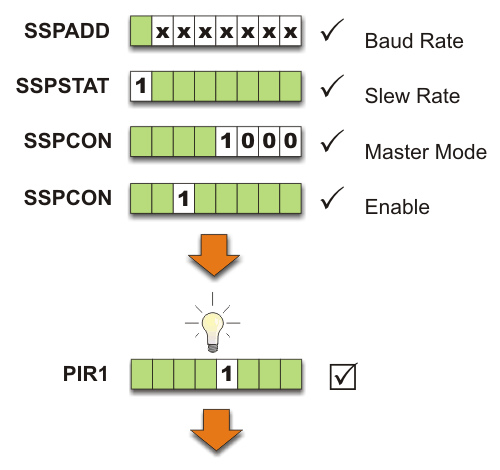
Fig. 6-27 I²C in Master Mode
Data Transmission in I²C Master Mode
Each clock condition on the SDA pin starts with logic zero (0) which appears upon setting the SEN bit of the SSPCON2 register. Even enabled, the microcontroller has to wait a certain time before it starts communication. It is the so called "Start condition" during which internal preparations and checks are performed. If all conditions are met, the SSPIF bit of the PIR1 is set and data transfer starts as soon as the SSPBUF register is loaded.
Since maximum 112 integrated circuits may simultaneously share the same transmission line, the first data byte must contain address which matches only one slave device. Each component has its own address listed in the proper data sheet. The eighth bit of the first data byte specifies direction of data transmission, the microcontroller is to send or receive data. In this case, it is all about data receive and the eighth bit therefore is logic zero (0).
Fig. 6-28 Data Transmission in I²C Master Mode
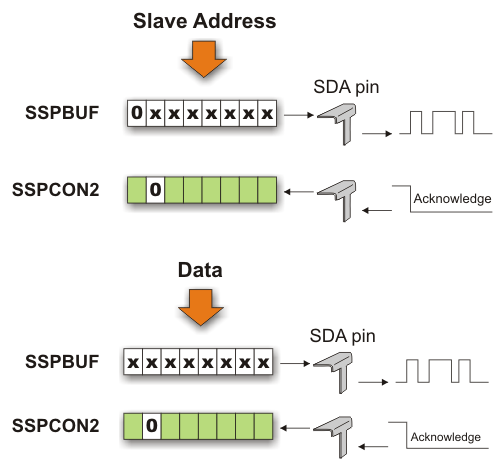
When address match occurs, the microcontroller has to wait for the acknowledge data bit. The slave device acknowledges address match by clearing the ASKSTAT bit of the SSPCON2 register. If the match properly occurred, all bytes representing data are transmitted in the same way.
Data transmission ends by setting the SEN bit of the SSPCON2 register. The so called STOP condition occurs, which enables the SDA pin to receive pulse condition: Start - Address - Acknowledge - Data - Acknowledge ....Data - Acknowledge - Stop!
Fig.6-29 Data Transmission in I²C Master Mode
Data Reception in I²C Master Mode
Preparations for data reception are similar to those for data transmission, with exception that the last bit of the first sent byte (containing address) is logic one (1). It specifies that master expects to receive data from addressed slave device. With regard to the microcontroller, the following events occur:After internal preparations are finished and START bit is set, slave device starts sending one byte at a time. These bytes are stored in the serial register SSPSR. Each data is, after receiving the last eighth bit, loaded to the SSPBUF register from where it can be read. By reading this register, the acknowledge bit is automatically sent, which means that master device is ready to receive new data.
At the end, similar to data transmission, data reception ends by setting the STOP bit:
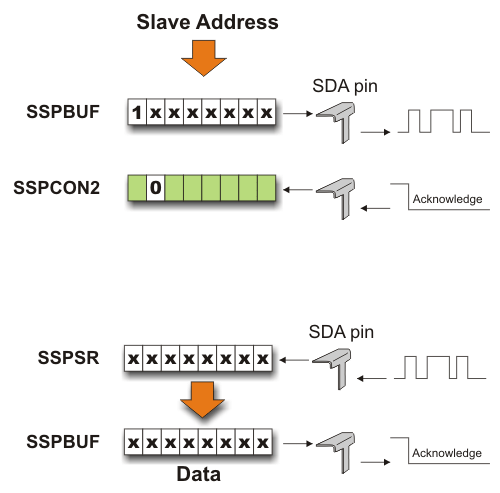
Fig. 6-30 Data Reception in I²C Master Mode
In this pulse condition, the acknowledge bit is sent to slave device.
Baud Rate Generator
In order to synchronize data transmission, all events taking place on the SDA pin must be synchronized with the clock generated in master device. This clock is generated by a simple oscillator whose frequency depends on the microcontroller’s main oscillator frequency, value written to the SSPADD register and the current SPI mode.The clock frequency of the mode described in this book depends on selected quartz crystal and the SPADD register. The formula used to calculate it is shown in figure below.
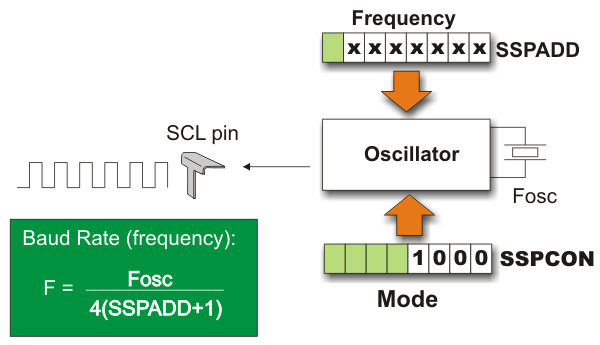
Fig. 6-31 Baud Rate Generator
Useful notes ...
When the microcontroller communicates with peripheral components, it may happen that data transfer fails for some reason. In that case, it is recommended to check the status of some bits which can clarify the problem. In practice, the state of these bits is checked by executing a short subroutine after each byte transmission and reception (just in case).WCOL (SPCON,7) - If you try to write a new data to the SSPBUF register while another data transmit/receive is in progress, the WCOL bit will be set and the contents of the SSPBUF register remains unchanged. Write does not occur. After this, the WCOL bit must be cleared in software.
BF (SSPSTAT,0) - In transmit mode, this bit is set when the CPU writes to the SSPBUF register and remains set until the byte in serial format is shifted from the SSPSR register. In receive mode, this bit is set when data or address is loaded to the SSPBUF register. It is cleared when the SSPBUF register is read.
SSPOV (SSPCON,6) - In receive mode, this bit is set when a new byte is received by the SSPSR register via serial communication, whereas the previously received data has not been read from the SSPBUF register yet.
SDA and SCL Pins - When SPP module is enabled, these pins turns into Open Drain outputs. It means that these pins must be connected to the resistors which, at the other end, are connected to positive power supply.
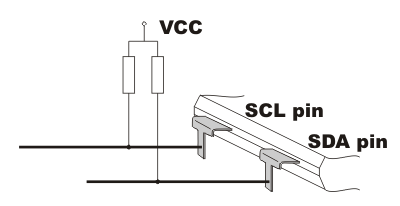
Fig. 6-32 Open Drain Output Resistors
In Short:
In order to establish serial communication in I²C mode, the following should be done:Setting Module and Sending Address:
- Value to determine baud rate should be written to the SSPADD register;
- SlewRate control should be turned off by setting the SMP bit of the SSPSTAT register;
- In order to select Master mode, binary value 1000 should be written to the SSPM3-SSPM0 bits of the SSPCON1 register;
- The SEN bit of the SSPCON2 register should be set (START condition);
- The SSPIF bit is automatically set at the end of START condition when the module is ready to operate. It should be cleared;
- Slave address should be written to the SSPBUF register; and
- When the byte is sent, the SSPIF bit (interrupt) is automatically set when the acknowledge bit has been received from the Slave device.
Data Transmit:
- Data is to be send should be written to the SSPBUF register;
- When the byte is sent, the SSPIF bit (interrupt) is automatically set upon the acknowledge bit has been received from Slave device; and
- In order to inform the Slave device that transmit is complete, STOP condition should be initiated by setting the PEN bit of the SSPCON register.
Data Receive:
- In order to enable receive the RSEN bit of the SSPCON2 register should be set;
- The SSPIF bit signals data receive. When data is read from the SSPBUF register, the ACKEN bit of the SSPCON2 register should be set in order to enable sending acknowledge bit; and
- In order to inform Slave device that transmit is complete, the STOP condition should be initiated by setting the PEN bit of the SSPCON register.